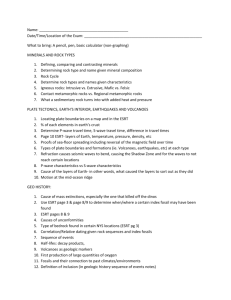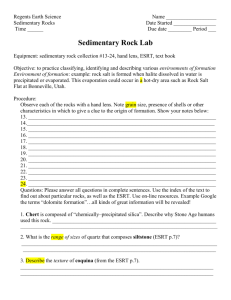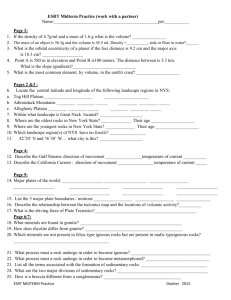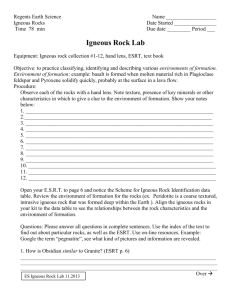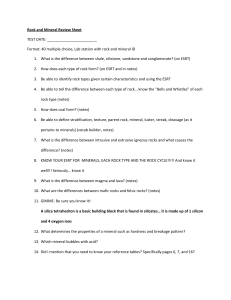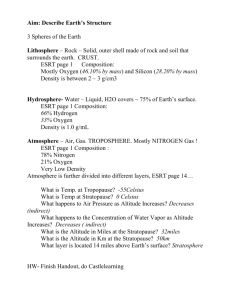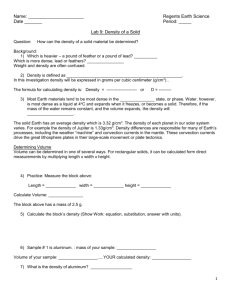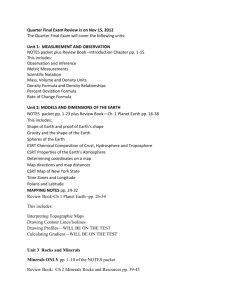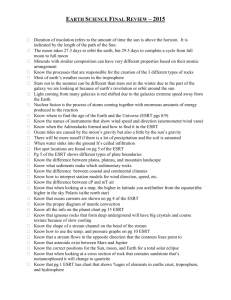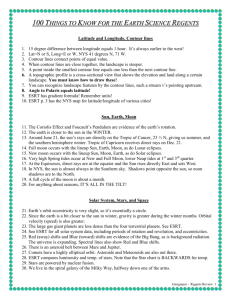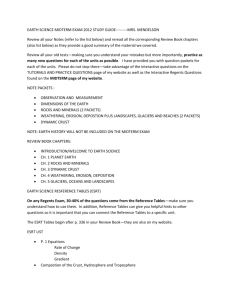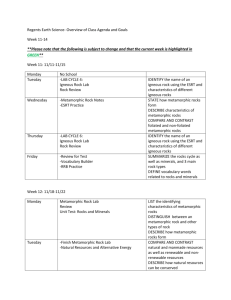ESRT Final Review Sheet & Answers
advertisement
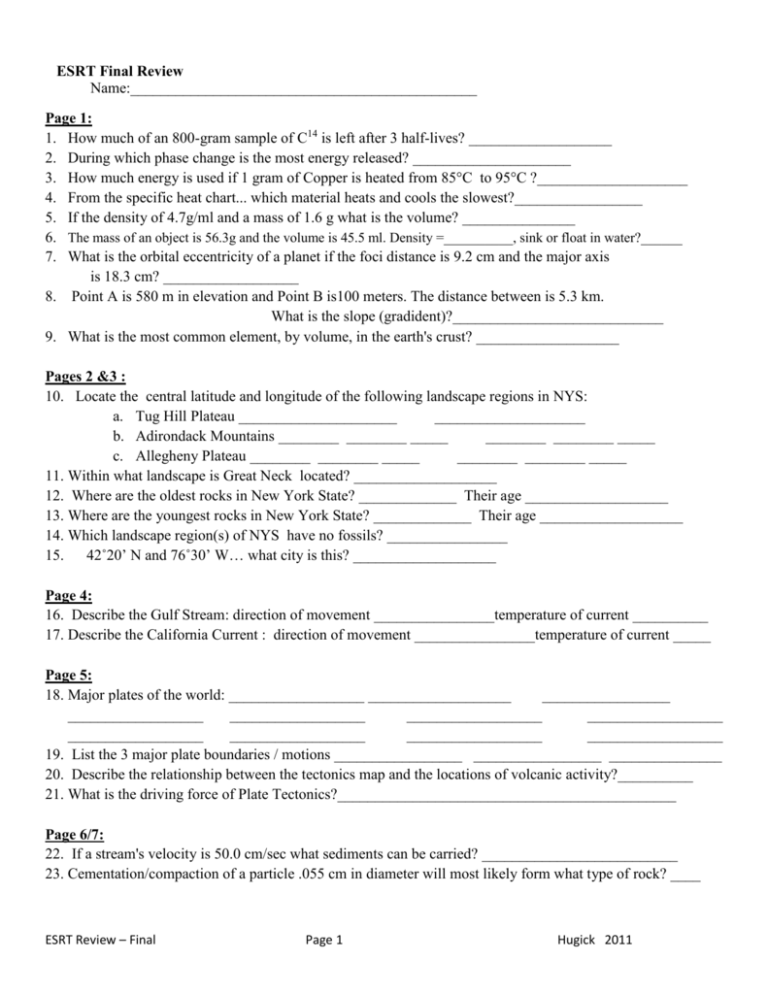
ESRT Final Review Name:______________________________________________ Page 1: 1. How much of an 800-gram sample of C14 is left after 3 half-lives? ___________________ 2. During which phase change is the most energy released? _____________________ 3. How much energy is used if 1 gram of Copper is heated from 85°C to 95°C ?____________________ 4. From the specific heat chart... which material heats and cools the slowest?_________________ 5. If the density of 4.7g/ml and a mass of 1.6 g what is the volume? _______________ 6. The mass of an object is 56.3g and the volume is 45.5 ml. Density =__________, sink or float in water?______ 7. What is the orbital eccentricity of a planet if the foci distance is 9.2 cm and the major axis is 18.3 cm? __________________ 8. Point A is 580 m in elevation and Point B is100 meters. The distance between is 5.3 km. What is the slope (gradident)?____________________________ 9. What is the most common element, by volume, in the earth's crust? ___________________ Pages 2 &3 : 10. Locate the central latitude and longitude of the following landscape regions in NYS: a. Tug Hill Plateau _____________________ ____________________ b. Adirondack Mountains ________ ________ _____ ________ ________ _____ c. Allegheny Plateau ________ ________ _____ ________ ________ _____ 11. Within what landscape is Great Neck located? ___________________ 12. Where are the oldest rocks in New York State? _____________ Their age ___________________ 13. Where are the youngest rocks in New York State? _____________ Their age ___________________ 14. Which landscape region(s) of NYS have no fossils? ________________ 15. 42˚20’ N and 76˚30’ W… what city is this? ___________________ Page 4: 16. Describe the Gulf Stream: direction of movement ________________temperature of current __________ 17. Describe the California Current : direction of movement ________________temperature of current _____ Page 5: 18. Major plates of the world: __________________ ___________________ _________________ __________________ __________________ __________________ __________________ __________________ __________________ __________________ __________________ 19. List the 3 major plate boundaries / motions _________________ _________________ _______________ 20. Describe the relationship between the tectonics map and the locations of volcanic activity?__________ 21. What is the driving force of Plate Tectonics?_____________________________________________ Page 6/7: 22. If a stream's velocity is 50.0 cm/sec what sediments can be carried? __________________________ 23. Cementation/compaction of a particle .055 cm in diameter will most likely form what type of rock? ____ ESRT Review – Final Page 1 Hugick 2011 Page 6/7: continued… 24. What minerals are found in granite? _____________________________________________ 25. How does rhyolite differ from granite? ___________________________________________ 26. Which minerals are not present in felsic type igneous rocks but are present in mafic type igneous rocks? __________________________________________ 27. What process must a rock undergo in order to become igneous? ___________________________________ 28. What process must a rock undergo in order to become metamorphosed? ____________________________ 29. List all the terms associated with the formation of sedimentary rocks. _____________________________ 30. What are the two major divisions of sedimentary rocks? ________________________________________ 31. How is a breccia different from a conglomerate? __________________________________ 32. How is rock gypsum formed? __________________________________________________ 33. What are the main types of metamorphism? ______________________________________ 34. What are the two major textures of metamorphic rocks? ____________________________ 35. Complete: metamorphic rock ---------------> parent rock slate _________________ marble _________________ quartzite _________________ Page 8/9: 36. During which time period were trilobites common? _________________________________ 37. What is the approximate age of the Intrusion of the Palisades Sill? ____________________________ 38. Which span of geologic time is the longest? _______________________________________ 39. For how long did dinosaurs roam the earth? ______________________________________ 40. How long ago did dinosaurs become extinct? ______________________________________ 41. What was happening during the early Archean?____________________________________ 42. Describe the motions of North America from the Ordovician to the Tertiary. _____________ 43. When was the Taconic Orogeny and how did it happen? _____________________________ 44. When did the Atlantic Ocean started to open?____________________________________ 45. What is the official fossil of NYS (see cover/ page 1 )?____________________________________ 46. List two geologic periods where NO rock is recorded in NYS: __________________ ____________ 47. Fossil “U” is most similar to fossil “____________” 48. What is the time distribution of fossil “M” Eurypterus in NYS:_______________________________ Page 10: 49. Which earth layer is the most dense ?____________________________________ 50. What is the approximate pressure at the mantle-outer core interface? __________________ 51. In which zone of the earth is the Earth' s temperature change the greatest? ____________ 52. Describe where the Moho is located? ____________________________________________ 53. How thick is the asthenosphere? _______________________________________________ 54. What does ultramafic mean? __________________________________________________ ESRT Review – Final Page 2 Hugick 2011 55. What is the approximate depth of the Outer Core from beginning__________ to end ________. Page 11: 56. What is the scale on the y-axis? ________________________________ 57. What is the scale on the x-axis ? ________________________________ 58. If P waves arrive 5 minutes and 20 seconds before S waves from an earthquake, what is the distance of the observer from the epicenter? ________________________________________ 59. If the epicenter is 2.2 x 103 km (2,200 km) from the observer, how long did it take the P-wave to travel to the station? _________________________, S-Wave: _________________________________ 60. If a P-wave arrives at 14:36:50 and the S-wave arrives at 14:45:20, what is the origin time?? _______________ Page 12: 61. Find the dew point if the wet bulb reading is 3˚ C and the dry bulb is 6˚C _______________ 62. Find the air temp. (dry bulb) if the dew point is 15˚C and the wet bulb depression is 5˚_________ 63. What is the relative humidity if wet bulb is 4˚C and the dry bulb is 14˚C?___________________ 64. What is the relative humidity if the air temperature is 10˚C and the dew point is 6˚C?_________________ Page 13: 65. Find the equivalent values of the following: a) 64˚ F = __________ ˚C b) 64˚ C = __________ ˚ F b) 32˚ F = __________ ˚C d) -20˚C = __________ ˚F 66. Atmospheric Pressure convert: 30.00" Hg = ___________ mb 1004.0 mb = __________" Hg 67. What does the ESRT station Model show for: Wind direction:_________, Wind speed:_______ 68. What is the present weather symbol for thunderstorms? _____________ rainshowers:________________ 69. What is the moisture associated with a mT airmass?_____________________________________ 70. Draw a weather Station model for the following information: Town: Troyville Air temp = 54° F , Dew point= 48° F Relative Humidity= 42% , Winds= northeast @ 25 knots, Pressure= 1014.2 mb, up 0.6 last 3 hours Cloud cover= 75%, present weather= haze 71. Draw and label the following fronts. Color code and label where warm and cold air would be located. WARM FRONT COLD FRONT ESRT Review – Final Page 3 Hugick 2011 Page 14: 72. What happens to air pressure as atmospheric altitude increases? ____________________ 73. In the atmosphere, all of our weather is found within the _________________________ 74. At which zone in the atmosphere is the temperature > 50˚C? _________________ 75. Describe the relationship of winds and warm and wet climates. _______________________ 76. Which latitudes are associated with high pressure?_________, Low pressure____________ Page 15: 77. Which planet has an orbit that is most circular? ________________________________ 78. What planet has the longest period of revolution? __________________________________ 79. .Which planet is the least dense? ________________________________________________ 80. What color star is the Sun?_______________, Sirius _________________, Betelgeuse _______________. 81. During what stage do you find the largest stars? __________, smallest ________. 82. What four variables are used to classify stars? ___________, _____________, ___________,___________ Page 16: 83. What mineral is dark and cleaves into sheets? _____________________________________ 84. What mineral has a red streak? _________________________________________ 85. List two properties of olivine. 1. ____________________________ 2. __________________________ 86. What is the official NYS gem?______________________________________ 87. What are the chemical symbols for: Iron ________, Potassium ________, Sodium ________, Lead________ Magnesium________ 88. Make 10 of your own questions NOT covered in the above 89 !!!!! Good luck. (answer also) 1. 2. 3. 4, 5. 6. 7. 8. 9. 10. ESRT Review – Final Page 4 Hugick 2011 Answer Key ESRT Final Review Hugick 2011 1. 100.0 g 2. Condensation 3. 658.6 J 4. Liquid water 5. 0.3 ml 6. 12.4 g/ml sink 7. 0.503 8. 52.2 m/km 9. O 10. 43° 30’ N 75° 45’ W , 43° 45’ N 74° 30’ W, 42° 20’ N 76° 00’ W 11. Atlantic Coastal Plain 12. Adirondacks, Middle Proterzoic 13. Long Island (Atlantic Coastal) , Cretaceous & early Pleistocene 14. Adirondacks, Manhattan Prong, Hudson Highlands, Taconic…. 15. Buffalo 16. NE / W warm 17. S/ SW cold 18. ….. 19. Convergent , divergent, transform 20. Where plated collide- earthquake & volcano can occur. 21. Convection cells 22. Pebbles, sand, silt, cobbles 23. Sandstone 24. Potassium feldspar, quartz, plagioclase feldspar, biotite, amphibole 25. Grain size 26. Pyroxene olivine 27. Melting, crystallization 28. Pressure / heat 29. Compaction, cementation, deposition, weathering, erosion 30. Inorganic land derived, chemical organic 31. Grain shape 32. Evaporation 33. Regional , contact 34. Foliated / non-foliated 35. Shale, limestone, sandstone 36. All Paleozoic periods 37. 299 my 38. Precambrian 39. 185.5 my 40. 65.5 my ESRT Review – Final Page 5 Hugick 2011 41. Biological carbon 42. Away 43. Ordovician & Iapetus Ocean 44. Jurassic 45. Eurypterus 46. Permian, Paleozoic 47. X 48. Silurian 49. Inner core 50. 3.1 moa 51. Crust / lithosphere 52. Btwn Lithosphere and Asthenosphere 53. 700 km 54. Iron – solid 55. 2900 to 5100km 56. 2000km 57. 20 sec 58. 3800 km 59. 4 min 20 sec, 8 min 60. 0:04:30 61. -1 °C 62. 20 °C 63. 8°C 64. 72% 65. 18, 0, 147. -4 66. 1016.0, 29.65 67. SW 15 knots 68. 69. High moisture 142 54 +6 70. 48 Troyville 71. COLD AIR WARM AIR WARM AIR COLD AIR 72. Decreases 73. Troposphere 74. Mesosphere 75. Convergent air 76. 30,90 0,60 77. Venus 78. Neptune 79. Saturn ESRT Review – Final Page 6 Hugick 2011 80. Yellow, blue/white, red 81. Intermediate. Late 82. Color, temp, mass, luminosity 83. Biotite 84. Hematite 85. Hardness 6.5 , green color , grainy 86. Garnet 87. Fe, K, Na, Pb, Mg ESRT Review – Final Page 7 Hugick 2011
